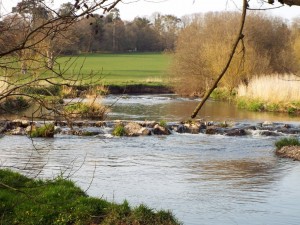The light weight UV protected fishing shirts have now made their way to the back of the wardrobe and been replaced with the thermals in readiness for getting out in freezing temperatures for some winter fly fishing. Although shirts with UV protection built in seemed a bit optimistic with the weather we had last summer.
For many, the end of the river trout season spells the time to retire the kit to its winter storage home as the warm fire beckons and the thought of standing in ice cold water for a few hours quite literally sends shivers down the spine.
For me, the fly fishing itch is just too strong to not scratch until the following spring so I like to keep throwing the fluff all year round and winter grayling fishing certainly hits the spot for me. Like so many others, contemplating standing in waist deep in freezing water whilst sitting in front of that warm fire seems like a no contest but with a bit of careful thought of what is the right kit for the conditions and the day out it’s now something that doesn’t faze me at all.
Starting with your waders, you have a couple of options here. You either use your summer lightweight breathable set and layer up underneath or invest in some thicker material waders like a thick Neoprene pair and then not go with the extra under layers.
For most, winter trips tend to be less frequent and the thought of forking out for another set of waders just for these occasional forays just doesn’t cut it, so if this is you invest in some decent base layers instead. Go for breathable base layers as these will allow the moisture to pass through them from sweating (yes you will sweat even in freezing conditions!) If you wear basic base layers that trap moisture, then this moisture in turn becomes cold and lowers the body’s temperature by being trapped next to the skin. In really cold conditions it’s best to opt for a base layer then a mid-layer over the top. Like most kit, you really get what you pay for, so the more you spend on an item the more likely you are to get a more technically advanced material that’s going to keep you warmer.
My next must have winter accessory is a pair of decent gloves. Even if you’re not wearing them to fish it’s still nice to give your hands a break from the cold when you’re having a break or walking to and from the beat. I like the Sealskinz brand, again these are breathable, they’re also pretty thin and lightweight, if you want to fish wearing them the fingers are removable to make things a bit easier. They are the best I’ve used on the market and I never leave home without mine in the winter. Hand warmers are a useful addition to carry as well, especially when you need to bring your fingers to life when it comes to tying that that all important knot.
As most people know, a lot of heat is lost through the head (especially if you have a head of hair like mine!) with this in mind invest in a decent thermal hat, something that covers the ears is useful. When it comes to your hat purchase, think function not fashion!
A couple other items you might want to take on your winter outing is a flask of hot drink, not alcohol as this has an adverse effect on your body’s temperature contrary to popular belief. A tub of Loon Stanley’s Ice Off can come in useful for those days when you have ice forming on your rod rings, although conditions may be too extreme for some if this is happening. Most importantly, a spare set of dry, warm clothes in case you take a dunking, and we all think it will never happen to us but believe me you don’t want to prove yourself wrong when you’re stood on an icy bank miles from home. If you start to feel the cold when wading climb out of the water and have a brisk walk along the bank, use this warm up time to check out the next pools you might fish and to check for any redds in the shallower runs that you should avoid disturbing.
So there you have it, with a bit of fore planning and the right kit, winter fly fishing may not be as daunting as you’re thinking whilst you’re sat in front of that warming fire, so give it a go and no matter how cold it is you will soon forget the low temperatures when that monster grayling slides towards the net.





